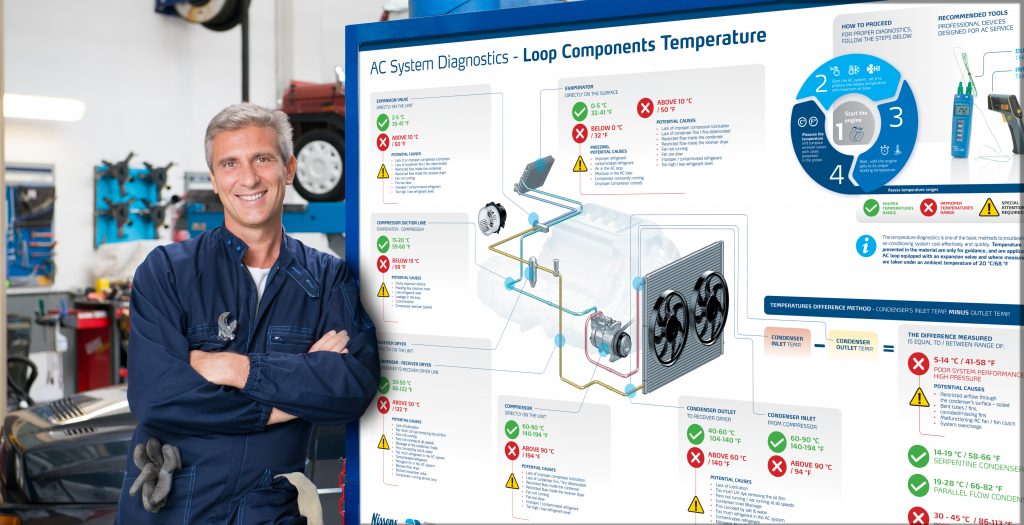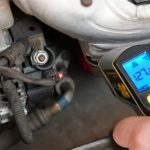Keeping a car’s A/C system running at peak performance requires the technician to monitor the health of the underlying components, using a variety of metrics, including temperature. By knowing where and what to measure, you can save valuable time when examining the system, as Nissens explains.
Something that many technicians might not know is that by measuring temperatures at the correct places in the climate system, they can troubleshoot the A/C system cost-effectively and quickly – saving valuable time and money.
One way of conducting temperature diagnostics on the climate system is through the temperature difference method, which means measuring the condenser’s inlet minus the outlet temperatures, and then comparing it to the appropriate range based on the manufacturer’s suggested temperature points. This helps to highlight poor system performance due to high pressure within that part of the system. Michael Ingvardsen, Nissens’ Training Manager and climate specialist, explains:
“When customers take their vehicles in for service, they often can’t exactly pinpoint what the problem is. They know that their A/C system isn’t working correctly, but they don’t know why. Nissens trains technicians to take the information they get from customers and use that to aid in their search for the answers and come to a conclusion quickly.”

What are the issues?
When it comes to temperature, any number of issues can affect it. If the measured temperature falls outside either end of the recommended temperature ranges, it could be due to:
■ Restricted airflow from internal clogs or contamination
■ Faulty valves
■ Leakage in the loop
■ A malfunctioning condenser, A/C fan or fan clutch
■ Lack of lubrication
Looking elsewhere within the A/C system loop, measuring temperatures at various points can also give mechanics important information about the health of the system. Temperatures may not directly reveal the refrigerant charge levels, but overcharging can generate higher pressure and heat, which can then affect the compressor (along with other components), and even lead to failure.
An example of how temperature diagnostics can help technicians can be seen if the evaporator begins freezing. This brings the measured temperature below prescribed levels. Here, air or moisture in the A/C loop should be considered as possible culprits, along with possible improper or contaminated refrigerant.
How can technicians spot temperature-related issues?
It is imperative that you are up-to date on different issues relating to the climate system loop, and how to read the temperatures to best diagnose potential problems, based on manufacturers’ recommended information. Temperatures that fall above or below the expected ranges can highlight different issues, so are the starting point for further investigation.
Customers will often be the first ones to find some sort of problem within the A/C system, as they will notice a slow down or lack of effective cooling inside the vehicle cabin, and may even notice lowered gas mileage over an extended period of time. Mechanics should then perform temperature measurements throughout the loop to determine where within the system the problem may be located.

So, what can technicians do?
Whenever a technician has a vehicle in front of them with a cooling issue, measuring temperature outputs of the system gives them a quick and cost-effective method of diagnosis of a wide range of problems that could be affecting the functionality. Based on the temperature measurements and further investigation, and along with replacement of any faulty components, Nissens argues that a
thorough flushing and cleaning of the system should be performed to ensure that it is free of contaminants or particles that can cause similar issues over time.
To easily identify the correct temperature ranges for the climate system, and causes of abnormalities in these temperatures, Nissens has developed a free technical temperature diagnostics poster that provides a complete overview of possible causes and solutions. The poster can be downloaded for free at www.nissens.com/climate.










